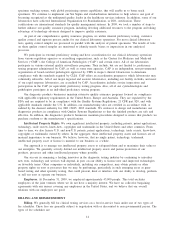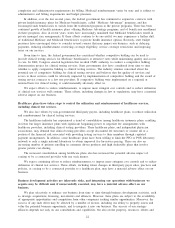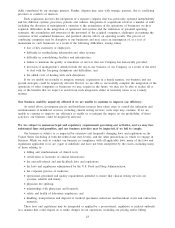Quest Diagnostics 2009 Annual Report Download - page 33
Download and view the complete annual report
Please find page 33 of the 2009 Quest Diagnostics annual report below. You can navigate through the pages in the report by either clicking on the pages listed below, or by using the keyword search tool below to find specific information within the annual report.skills contributed by our strategic partners. Further, disputes may arise with strategic partners, due to conflicting
priorities or conflicts of interests.
Each acquisition involves the integration of a separate company that was previously operated independently
and has different systems, processes, policies and cultures. Integration of acquisitions involves a number of risks
including the diversion of management’s attention to the assimilation of the operations of businesses we have
acquired, difficulties in the integration of operations and systems and the realization of potential operating
synergies, the assimilation and retention of the personnel of the acquired companies, challenges in retaining the
customers of the combined businesses, and potential adverse effects on operating results. The process of
combining companies may be disruptive to our businesses and may cause an interruption of, or a loss of
momentum in, such businesses as a result of the following difficulties, among others:
•loss of key customers or employees;
•difficulty in standardizing information and other systems;
•difficulty in consolidating facilities and infrastructure;
•failure to maintain the quality or timeliness of services that our Company has historically provided;
•diversion of management’s attention from the day-to-day business of our Company as a result of the need
to deal with the foregoing disruptions and difficulties; and
•the added costs of dealing with such disruptions.
If we are unable successfully to integrate strategic acquisitions in a timely manner, our business and our
growth strategies could be negatively affected. Even if we are able to successfully complete the integration of the
operations of other companies or businesses we may acquire in the future, we may not be able to realize all or
any of the benefits that we expect to result from such integration, either in monetary terms or in a timely
manner.
Our business could be negatively affected if we are unable to continue to improve our efficiency.
As noted above, government payers and healthcare insurers have taken steps to control the utilization and
reimbursement of healthcare services, including clinical testing services; such steps may continue. If we are
unable to continue to improve our efficiency to enable us to mitigate the impact on our profitability of these
activities, our business could be negatively affected.
We are subject to numerous legal and regulatory requirements governing our activities, and we may face
substantial fines and penalties, and our business activities may be impacted, if we fail to comply.
Our business is subject to or impacted by extensive and frequently changing laws and regulations in the
United States (including at both the federal and state levels), and the other jurisdictions in which we engage in
business. While we seek to conduct our business in compliance with all applicable laws, many of the laws and
regulations applicable to us are vague or indefinite and have not been interpreted by the courts, including many
of those relating to:
•billing and reimbursement of clinical tests;
•certification or licensure of clinical laboratories;
•the anti-self-referral and anti-kickback laws and regulations;
•the laws and regulations administered by the U.S. Food and Drug Administration;
•the corporate practice of medicine;
•operational, personnel and quality requirements intended to ensure that clinical testing services are
accurate, reliable and timely;
•physician fee splitting;
•relationships with physicians and hospitals;
•safety and health of laboratory employees; and
•handling, transportation and disposal of medical specimens, infectious and hazardous waste and radioactive
materials.
These laws and regulations may be interpreted or applied by a prosecutorial, regulatory or judicial authority
in a manner that could require us to make changes in our operations, including our pricing and/or billing
23
























